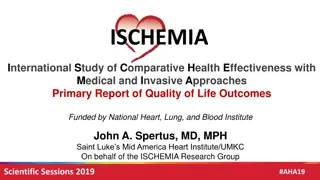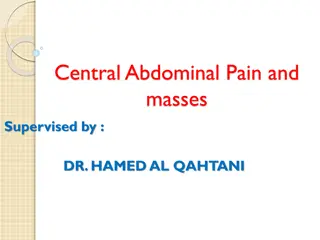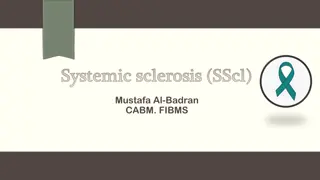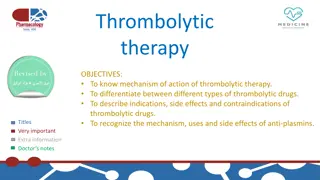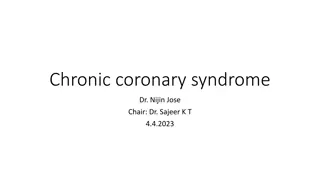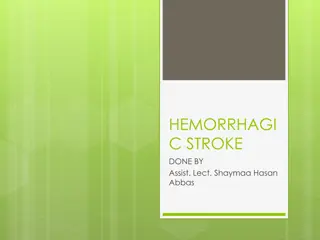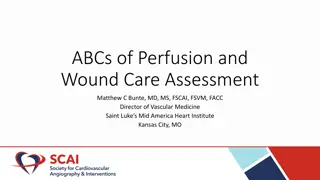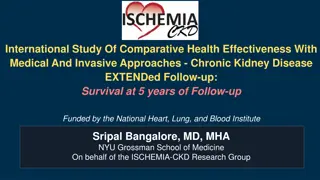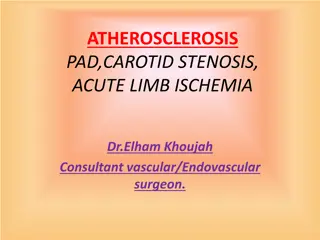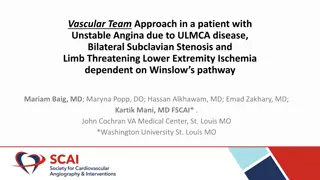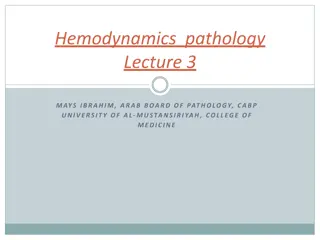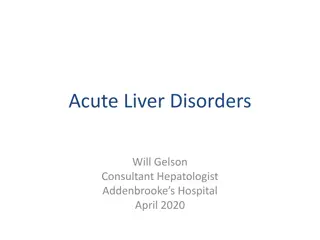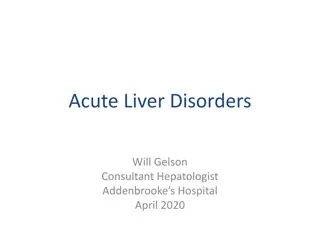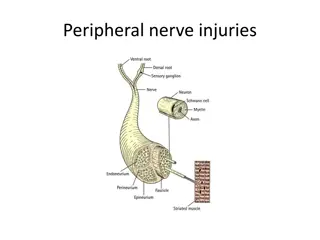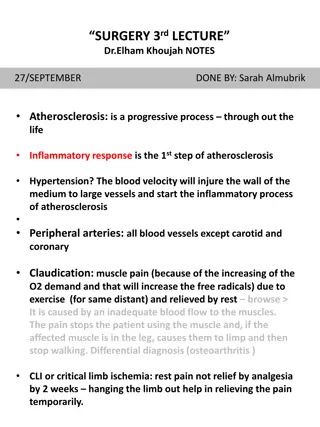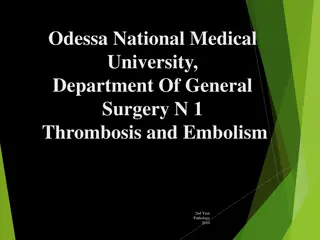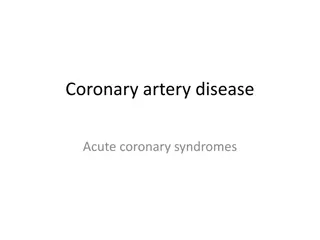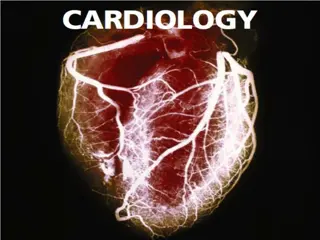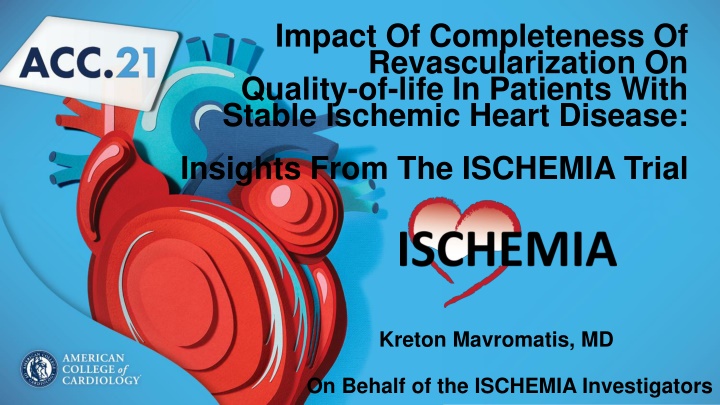
Impact of Completeness of Revascularization on Quality of Life in Stable Ischemic Heart Disease
Explore the influence of complete revascularization on quality of life in stable ischemic heart disease patients through insights from the ISCHEMIA trial. The study delves into the impact of anatomical or functional completeness of revascularization on outcomes, comparing it with conservative management. Key outcome measures include Seattle Angina Questionnaire scores, with a focus on angina frequency, quality of life, physical limitations, and more.
Download Presentation

Please find below an Image/Link to download the presentation.
The content on the website is provided AS IS for your information and personal use only. It may not be sold, licensed, or shared on other websites without obtaining consent from the author. If you encounter any issues during the download, it is possible that the publisher has removed the file from their server.
You are allowed to download the files provided on this website for personal or commercial use, subject to the condition that they are used lawfully. All files are the property of their respective owners.
The content on the website is provided AS IS for your information and personal use only. It may not be sold, licensed, or shared on other websites without obtaining consent from the author.
E N D
Presentation Transcript
Impact Of Completeness Of Revascularization On Quality-of-life In Patients With Stable Ischemic Heart Disease: Insights From The ISCHEMIA Trial Kreton Mavromatis, MD On Behalf of the ISCHEMIA Investigators
Disclosures None
Design of the ISCHEMIA Trial CABG PCI > Moderate- Risk Stress Test or + Angina-related QoL
Key Clinical Question Does the Completeness of Revascularization (Anatomic or Functional) Influence Outcomes? CABG PCI > Moderate- Risk Stress Test or + Angina-related QoL
Angiographic Core Laboratory* Assessment of Anatomic and Functional Completeness of Revascularization After PCI and CABG PCI: CR assessed by review of pre- and post-procedure angiograms (includes planned staged procedures) CABG: CR assessed by review of pre-procedure angiograms and CABG procedure reports; accounts for diseased vessel segments and side branches Anatomic CR: Revasc of all lesions with QCA RVD 2.0 mm and QCA DS 50% Functional CR: Revasc of all lesions with QCA RVD 2.0 mm and: Localizing FFR/iFR 0.80/0.89 plus QCA DS 30% Localizing non-invasive ischemia in the vessel distribution plus QCA DS 50% Non-localizing severe ischemia by ETT plus QCA DS 60% QCA DS 70% *Cardiovascular Research Foundation, NY Modified from Ali Z et al. J Am Heart Assoc. 2021:e020110. doi: 10.1161/JAHA.120.020110
Key Outcome Measures Seattle Angina Questionnaire 7 Angina Frequency Quality of Life Physical Limitations SAQ Summary Score Rose Dyspnea Score (RDS) Primary Outcome Adjusted SAQ Summary Score at 1 year
Objectives Objective 1: Compare complete (CR) vs. incomplete revascularization (ICR) among invasively managed, revascularized patients Proportional odds model used to adjust for 24 clinical and angiographic variables Results expressed as odds ratio of better QOL for CR vs. ICR Objective 2: Compare the expected outcomes of CR vs. conservative management in the overall ISCHEMIA population Propensity weighting used to rebalance patient characteristics for CR to mirror the overall population Results expressed as expected difference in mean QOL scores.
Objectives (cont) Analyses were performed for all patients and patients stratified by: Baseline angina frequency Baseline ischemia Presence of CTOs
Objective 1: CR vs ICR in Invasively Managed Patients Patient Flow Randomized to INV Brief QoL Angiographic core lab No Prior CABG Revasc. within 180 days No event before revasc N=1641
CR vs ICR in Invasively Managed Patients Select Baseline Clinical Characteristics P-Value P-Value Anatomic CR Functional CR CR ICR n = 918 64.1 9.2 174 (19.0%) 721 (78.7%) 367 (40.0%) 197 (21.5%) 46 (5.0%) 60.0 8.1 29.0 4.8 73.3 19.0 79.8 20.8 1.2 1.3 CR ICR n = 660 64.1 9.3 125 (18.9%) 523 (79.5%) 264 (40.0%) 146 (22.2%) 42 (6.4%) 59.7 8.0 29.2 5.0 73.2 18.7 79.5 20.4 1.2 1.3 n = 701 63.4 9.7 181 (25.8%) 509 (72.9%) 295 (42.1%) 125 (17.9%) 31 (4.4%) 61.0 8.0 28.3 4.8 72.1 18.8 79.5 19.7 1.2 1.3 n = 904 63.6 9.5 208 (23.0%) 671 (74.5%) 370 (40.9%) 161 (17.8%) 34 (3.8%) 60.9 8.0 28.3 4.6 72.6 19.0 79.9 20.2 1.2 1.3 Age Female Hypertension Diabetes Prior MI Peripheral vascular disease Ejection fraction Body mass index SAQ-7 Summary Score SAQ-7 Angina Frequency Score Rose Dyspnea Scale 0.147 < 0.001 0.006 0.393 0.074 0.582 0.005 0.003 0.158 0.334 0.293 0.403 0.052 0.021 0.711 0.034 0.017 0.001 0.001 0.624 0.838 0.327 No difference in completeness of revascularization by baseline symptoms or QoL
More Complex Anatomy Associated with ICR Select Baseline Anatomy and Revascularization Strategy P-Value P-Value Anatomic CR CR n = 701 Funtional CR ICR n = 918 CR ICR n = 660 n = 904 # of vessels > 70% (CCTA) 0 1 2 3 SYNTAX score <23 23 to <33 >= 33 Number of CTOs 0 1 2 >3 First revascularization PCI CABG < 0.001 < 0.001 48 (8.7%) 171 (31.1%) 82 (14.9%) 39 (7.1%) 25 (3.6%) 178 (25.5%) 144 (20.7%) 114 (16.4%) 48 (6.8%) 220 (31.1%) 111 (15.7%) 61 (8.6%) 16 (3.2%) 122 (24.1%) 110 (21.7%) 92 (18.2%) < 0.001 < 0.001 577 (82.3%) 99 (14.1%) 25 (3.6%) 499 (54.4%) 250 (27.2%) 169 (18.4%) 697 (77.1%) 159 (17.6%) 48 (5.3%) 329 (49.8%) 186 (28.2%) 145 (22.0%) < 0.001 < 0.001 475 (67.9%) 194 (27.7%) 30 (4.3%) 1 (0.1%) 411 (44.8%) 401 (43.7%) 87 (9.5%) 18 (2.1%) 587 (65.0%) 275 (30.5%) 39 (4.3%) 2 (0.2%) 249 (37.7%) 315 (47.7%) 78 (11.8%) 17 (2.8%) < 0.001 < 0.001 551 (78.6%) 150 (21.4%) 651 (70.9%) 267 (29.1%) 697 (77.1%) 207 (22.9%) 455 (68.9%) 205 (31.1%)
Adjusted QoL Outcomes Favor CR, Particularly with Functional CR Adjusted Outcomes at 1 year Effect of Anatomic Revascularization Among All Patients Effect of Functional Revascularization Among All Patients Effect of Anatomic Revascularization Among All Patients Effect of Functional Revascularization Among All Patients SAQ-7 Summary Score 1.09 (0.86, 1.37) SAQ-7 Summary Score 1.24 (1.00, 1.55) SAQ-7 Angina Frequency Score SAQ-7 Summary Score 1.37 (1.00, 1.88) 1.09 (0.86, 1.37) SAQ-7 Angina Frequency Score SAQ-7 Summary Score 1.35 (1.01, 1.81) 1.24 (1.00, 1.55) SAQ-7 Quality of Life Score SAQ-7 Angina Frequency Score 0.98 (0.77, 1.25) 1.37 (1.00, 1.88) SAQ-7 Quality of Life Score SAQ-7 Angina Frequency Score 1.17 (0.93, 1.48) 1.35 (1.01, 1.81) SAQ-7 Physical Limitation Score SAQ-7 Quality of Life Score 1.21 (0.92, 1.60) 0.98 (0.77, 1.25) SAQ-7 Physical Limitation Score SAQ-7 Quality of Life Score 1.25 (0.96, 1.62) 1.17 (0.93, 1.48) Rose Dyspnea Scale SAQ-7 Physical Limitation Score 1.29 (0.98, 1.70) 1.21 (0.92, 1.60) Rose Dyspnea Scale SAQ-7 Physical Limitation Score 1.31 (1.01, 1.71) 1.25 (0.96, 1.62) EQ-5D Visual Analog Scale Rose Dyspnea Scale 1.07 (0.85, 1.34) 1.29 (0.98, 1.70) EQ-5D Visual Analog Scale Rose Dyspnea Scale 1.10 (0.88, 1.37) 1.31 (1.01, 1.71) 0.5 Favors ICR 1 2 0.5 Favors ICR 1 2 EQ-5D Visual Analog Scale 1.07 (0.85, 1.34) EQ-5D Visual Analog Scale 1.10 (0.88, 1.37) Favors CR Favors CR Odds Ratio 1 Odds Ratio 1 0.5 2 0.5 2 Effect of Anatomic Revascularization Among Patients with Angina Effect of Functional Revascularization Among Patients with Angina Odds Ratio Odds Ratio Effect of Anatomic Revascularization Among Patients with Angina Effect of Functional Revascularization Among Patients with Angina SAQ-7 Summary Score 1.05 (0.80, 1.38) SAQ-7 Summary Score 1.22 (0.93, 1.61) SAQ-7 Angina Frequency Score SAQ-7 Summary Score 1.35 (0.95, 1.91) 1.05 (0.80, 1.38) SAQ-7 Angina Frequency Score SAQ-7 Summary Score 1.34 (0.95, 1.87) 1.22 (0.93, 1.61) SAQ-7 Quality of Life Score SAQ-7 Angina Frequency Score 0.94 (0.70, 1.26) 1.35 (0.95, 1.91) SAQ-7 Quality of Life Score SAQ-7 Angina Frequency Score 1.17 (0.89, 1.55) 1.34 (0.95, 1.87) SAQ-7 Physical Limitation Score SAQ-7 Quality of Life Score 1.21 (0.86, 1.69) 0.94 (0.70, 1.26) SAQ-7 Physical Limitation Score SAQ-7 Quality of Life Score 1.34 (0.97, 1.85) 1.17 (0.89, 1.55) Rose Dyspnea Scale SAQ-7 Physical Limitation Score 1.37 (0.98, 1.92) 1.21 (0.86, 1.69) Rose Dyspnea Scale SAQ-7 Physical Limitation Score 1.33 (0.97, 1.84) 1.34 (0.97, 1.85) EQ-5D Visual Analog Scale Rose Dyspnea Scale 1.01 (0.76, 1.34) 1.37 (0.98, 1.92) EQ-5D Visual Analog Scale Rose Dyspnea Scale 1.15 (0.89, 1.50) 1.33 (0.97, 1.84) 0.5 1 2 0.5 1 2 EQ-5D Visual Analog Scale 1.01 (0.76, 1.34) EQ-5D Visual Analog Scale 1.15 (0.89, 1.50) Odds Ratio 1 Odds Ratio 1 0.5 2 0.5 2 Odds Ratio Odds Ratio
CR improves health status more than ICR for patients with daily/weekly angina Covariate adjusted odds ratios for better health status-CR vs ICR at 1 year Baseline Daily/Weekly Angina Baseline Monthly Angina Baseline No Angina Interaction P-value Anatomic CR vs ICR SAQ-7 Summary Score SAQ-7 Angina Frequency Score 1.62 (1.07, 2.44) 2.20 (1.28, 3.77) 0.89 (0.66, 1.19) 1.03 (0.70, 1.52) 1.13 (0.78, 1.63) 1.44 (0.80, 2.61) 0.04 0.04 Functional CR vs ICR SAQ-7 Summary Score SAQ-7 Angina Frequency Score 1.55 (1.03, 2.34) 2.01 (1.22, 3.31) 1.18 (0.88, 1.59) 1.13 (0.76, 1.69) 1.14 (0.80, 1.63) 1.19 (0.67, 2.10) 0.44 0.14 No association of CR benefit with ischemia burden or number of CTOs
Objective 2: Invasive-CR vs Conservative Patient Flow Randomized N=5179 Brief QoL Data N=4617 No Prior CABG N=4421 Randomized to CON N=2232 Randomized to INV N=2189 Core Lab N=2059 No Core Lab N=130 + Sig. Lesions Anat: N = 1853 Func: N = 1755 No Sig. Lesions Anat: N = 206 Func: N = 304 ICR No Revasc Anat: N = 206 Func: N = 162 CR. Anat: N = 943 Func: N = 681 Anat: N = 704 Func: N = 912
Objective 2: INV-FCR vs CON Propensity weighted SAQ scores CON CON INV-FCR INV-FCR
INV-CR vs CON vs. Randomized ISCHEMIA Adjusted mean difference in QoL scores at 1 year ISCHEMIA Trial* ISCHEMIA CR Substudy Analysis INV-ACR vs. CON 4.3 (3.2, 5.6) 4.3 (3.3, 5.2) 5.6 (3.8, 7.6) 3.0 (1.4, 4.7) -0.2 (-0.3, -0.1) INV-FCR vs. CON 4.3 (3.1, 5.5) 4.7 (3.6, 5.6) 5.9 (3.7, 7.8) 3.3 (1.8, 4.8) -0.2 (-0.3, -0.1) INV vs. CON 3.7 (2.9, 4.6) 3.7 (2.8, 4.6) 4.6 (3.3, 6.0) 2.6 (1.5, 3.8) -0.1 (-0.2, -0.1) SAQ-7 Summary Score SAQ-7 Angina Frequency Score SAQ-7 Quality of Life Score SAQ-7 Physical Limitation Score Rose Dyspnea Scale *Excluded: Pts with prior CABG
Freedom from Angina Highest in INV-CR 100 75 Freedom from Angina CON INV-ACR 50 INV-FCR INV 25 0 Daily/Weekly Monthly None Baseline Angina Frequency
Benefits differ by Baseline Angina, but Not by Ischemia Daily/Weekly Angina Monthly Angina No Interaction P-value Angina Baseline Angina INV-FCR vs CON SAQ-7 Summary Score SAQ-7 Angina Frequency Score Freedom from angina (OR) 1.8 (0.3, 3.4) 1.9 (0.9, 3.0) 1.62 (1.15, 2.26) <0.001 <0.001 <0.001 7.0 (4.3, 9.9) 7.7 (4.8, 10.8) 2.31 (1.55, 3.44) 5.4 (3.5, 7.1) 4.9 (3.5, 6.3) 2.35 (1.65, 3.14) No-Mild Ischemia Moderate Ischemia Severe Ischemia Interaction P-value Baseline Ischemia INV-FCR vs CON SAQ-7 Summary Score SAQ-7 Angina Frequency Score Freedom from angina (OR) 0.83 0.43 0.41 3.9 (1.2, 6.6) 2.8 (-0.0, 5.5) 1.69 (1.13, 2.59) 4.9 (3.1, 6.9) 4.8 (3.1, 6.6) 2.17 (1.58, 2.92) 4.4 (2.4, 6.0) 4.7 (3.5, 5.9) 2.36 (1.69, 3.14)
Limitations Observational comparison, so association cannot be equated with causality Methods to match/adjust used 24 prospectively-collected, clinical and angiographic factors However, we acknowledge likely residual confounding No sham group cannot exclude placebo effect--however, benefit in QoL comparable to the sham-controlled ORBITA Trial
Conclusions (1) CR is associated with a greater improvement in angina-related quality of life than ICR, particularly in patients with baseline weekly/daily angina Functional CR is at least as effective as anatomic CR in improving angina-related quality of life
Conclusions (2) Invasive management achieving CR improves angina-related quality of life more than conservative management, with greater benefits in the patients with more angina. Stress-induced ischemia burden on non-invasive testing and presence of CTOs do not identify patients who benefit more or less from CR.
Clinical Implications These results suggest that, for patients with chronic coronary disease and angina who are being managed invasively, the safe achievement of CR will optimize quality of life.
Thank you.. John Spertus, Gregg Stone Quality of Life Core Lab: Philip Jones ISCHEMIA Trial Chair & Co-Chair: Judith Hochman, David Maron ISCHEMIA Quantitative Coronary Angiography Core Lab: Ziad Ali, Jennifer Horst ISCHEMIA Analytic Center: Sean O Brien, Ovidiu Dressler, Grace Rhodes


